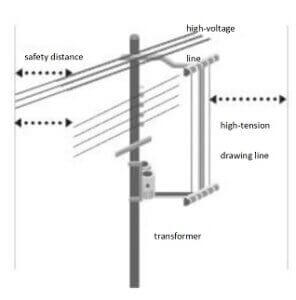[Chapter 3] Section 3 Prevention of Electric Shock Hazards
1 Prevention of Electric Shock Hazards
(1) Electric shock is defined as the risk of electric current flowing to the human body due to factors such as improper use of electrical products or equipment, human bodies or work equipment being caught in power lines during electrical work, electrical leakage, and a natural disaster such as being struck by lightning, resulting in damage to the human body.
The human body has low electrical resistance (electricity flows easily), but when the skin is wet with water or sweat, the electrical resistance becomes even lower (electricity flows more easily), thereby increasing its danger. In addition, if the heart is located between the point where electricity enters the body by touching the source of the electric shock (the point of entry) and the point where electricity leaves the body after a ground fault is established (the point of exit), the possibility of ventricular fibrillation or cardiac arrest increases.
In the 1970s, there were more than 100 to 200 fatal accidents caused by electric shock every year, but with the enforcement of the Occupational Safety and Health Act in 1972, the Ordinance on Industrial Safety and Health made the installation of ground-fault circuit breakers partially mandatory and promoted safety measures for electrical work. This has resulted in a year-to-year decline to about 10 to 20 fatalities (the number of fatalities due to electric shock is 1 to 2% of all work-related fatalities).
Nevertheless, the ratio of fatalities to the number of workers killed or injured in electrocution accidents that result in four or more days of absence from work is more than 10%, making these accidents “highly fatal” among occupational accidents, and therefore, it is necessary to implement solid disaster prevention measures.
(2) When an electric current is applied to the human body, depending on the magnitude of the current (the greater the danger), the time it passes through the human body (the longer the danger), and the path of the current (a heart in the path of the current is dangerous), the effects on the human body can range from a “tingling” feeling to serious consequences such as burns, tissue destruction, ventricular fibrillation, and death..
The German “Keppen experiment” is known for determining the danger of electric current passing through the human body. Based on the idea that “a large current is dangerous even if it passes through the human body for a short time, while a small current is not dangerous even if it passes through the human body for a long time,” Keppen found that “the current passing through the human body [mA] x passing time [s] = constant. After various verifications, they proposed that the current-time product should be 50[mA・s] as the safety limit of the current passing through the human body.
(3) Current values and effects of passing current on the human body are considered to be as follows.
| Current value | Effects on human body |
|---|---|
| 0.5~1mA | ・Minimum detectable current, “tingling” sensation, no danger to the human body |
| 5mA | ・Maximum allowable current value that does not adversely affect the human body ・Reasonable pain is felt. |
| 10~20mA | ・Limitation of withdrawal (involuntary current), impairing voluntary muscle movement ・Sustained contraction of muscles, inability to release the wire |
| 50mA | ・Fatigue, pain, fainting, possible structural injury ・Occurrence of cardiac rhythm or higher, effects on the respiratory system, etc. ・Also said to generate a ventricular fibrillation current and may cause cardiopulmonary arrest. |
| 100mA | ・Ventricular fibrillation, cardiopulmonary arrest, extreme danger |
(4)Ordinance on Industrial Safety and Health
Article 349 (Prevention of Electric Shocks in Carrying Out the Work for Construction of Structures)
In carrying out the work such as constructing, dismantling, inspecting, repairing, and painting a structure or the work associated with them, or the work using a pile driver, pile drawer, mobile crane, etc., at a place in the vicinity of overhead wires or charged circuits of electric machine and appliance, when there is a risk of electric shocks to the worker engaging in the work due to the worker’ body, etc., coming into contact or coming in the vicinity of the charged circuits during work or when passing through, the employer must take measures that fall under any of the following items:
(i)to move the charged circuit to other places;
(ii)to install an enclosure to prevent the danger of electric shock;
(iii)to provide the charged circuit with insulating protective equipment; or
(iv)when taking measures falling under the preceding three items are extremely difficult, to place a watcher and have the watcher monitor the work

Distribution lines and safe separation distances
100~200V 1.0 m or more (by notification of the Director-General of the Labour Standards Bureau)
6,600V 1.2 m or more (same as above)
*Guidance by electric power companies 2.0 m or more
This does not apply if insulation protection is provided.
地域・講習・人数に合わせてすぐに予約可能
講習会を予約する受講者様のご希望に合わせ、以下のタイプの講習会もご用意しています

このページをシェアする
講習会をお探しですか?